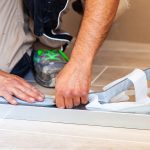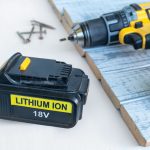The beginning of the year is a natural inflection point, and an opportune time to consider the latest code requirements related to insulating metal buildings. For contractors, architects, engineers, manufacturers and others in the metal building industry, code changes often revolve around modifications to insulation requirements that have been altered based on the latest testing. All construction stakeholders must ensure projects meet and exceed code requirements by tracking what is currently required, and what industry experts say works best. Here are six keys to success in 2020, highlighted by metal building insulation manufacturers.
Six keys to successfully insulate metal buildings in 2020

Filled cavity system, long tab banded, photo courtesy of Therm-All
1. Know Code Requirements
The first step to determine a project’s insulation is to know and fully understand all applicable code requirements, says Bill Beals, district manager at North Olmsted, Ohio-based Therm-All Inc. “Energy codes have cycled into more stringent roof and wall requirements, and with the evolution of energy code requirements, come the evolution of insulation systems,” he says. “IECC and ASHRAE 90.1 both set minimum standards of energy efficiency. Many states have adopted a version of IECC or ASHRAE 90.1. IECC 2012, 2015 and 2018 are the most adopted versions and all require in-place performance levels that require U-values that use liner system/filled cavity roof and wall insulation systems. U-values are thermal performance ratings for an assembly. R-values are thermal performance ratings of a product. Many climate zones require a U-value of U-0.035 for roof insulation. The walls vary from U-0.05 and U-0.052. As a contractor, you will need to choose the system that best works for the project and meets the in-place performance values by climate zone.”

Filled cavity system, long tab banded, photo courtesy of Therm-All
2. Know Code Requirements for Air Barriers
Another aspect of meeting building code requirements contractors should keep in mind for insulating metal buildings is the role of air barriers, says Robert Tiffin, national accounts manager at Silvercote LLC, Greenville, S.C.
“IECC 2015 and ASHRAE 90.1-2013 require buildings to have an air barrier in the thermal envelope,” Tiffin says. “The present requirement defines an air permeability not greater than 0.004 cubic feet per minute (CFM)/square foot when subjected to a pressure differential. In IECC 2015, the requirements are in section C 402.5.1 and C 402.5.1.1. Air barriers are not required in buildings in climate zone 2B. In ASHRAE 90.1-2013, the requirements are in sections 5.4.3, 5.4.3.1.1, and 5.4.3.1.2. Exceptions include semi-heated buildings in climate zones 1 to 6.”
Tiffin says the North American Insulation Manufacturers Association (NAIMA) and Metal Building Manufacturers Association (MBMA) are conducting a collaborative research project to identify air barrier baseline requirements and best practices for air barriers in metal buildings.*
“The motivation [is] the U.S. Army Corps of Engineers, a significant influencer, operates presently with a 0.25 CFM/square foot, and are undergoing tests to drive towards a 0.16 CFM/square foot,” Tiffin says. “In short, having an awareness of the more stringent horizons, and the knowledge of how to build to them are the keys for a contractor’s future.”
David Tomchak, director of marketing at Green Bay, Wis.-based Bay Insulation Systems Inc., says, “Air leakage and air infiltration in metal buildings is becoming a hot topic within the industry for 2020. The MBMA is currently conducting testing for the purpose of recommending best practices to help contractors insulate metal buildings. Contractors can contact either MBMA or MBCEA (Metal Building Contractors and Erectors Association) if they have questions regarding this initiative.”
3. Know Insulation Options
With equal attention to detail, while contractors should avail themselves of the latest code requirements relevant to insulating metal buildings, they should also be aware of different types of insulation systems, Beals says.
“For many years, contractors would automatically install a simple single-layer metal building insulation system, such as 6-inch R-19 roof and 4-inch R-13 wall insulation,” he says. “Though uncomplicated, we know now that this wasn’t energy efficient. Due to increasingly stringent code requirements and innovations in building envelope science, insulation systems for metal buildings look quite different than they did even a mere 15 years ago. There are a variety of different insulation systems that meet all the various envelope requirements throughout the country, including fiberglass systems, board insulation and insulated metal panels.”
In terms of fiberglass systems, Beals says those most often used to meet code include banded liner systems and long tab banded systems. “Both systems provide high R-value insulation and in place U-values to meet the latest codes, and both include two or three layers of fiberglass and banding,” he says. “However, there are several key differences between the two, including the vapor barrier used, aesthetic appearance, installation method and achievable U-values. Additionally, banded liner systems can be used for both the roof and walls, but long tab banded systems are typically roof only.”
In comparison, rigid insulation systems most often consist of a rigid polyisocyanurate or polyethylene foam core, Beals says. “There are various rigid insulation systems available to meet code, and building manufacturers have components for this application. Contractors also must understand board insulation applications do require specific fire testing to be used in exposed applications. Many off-the-shelf type board insulations do not meet the requirement. Additionally, insulated metal panels have gained market share in recent years, with specific focus on wall applications.”
4. Get COMcheck Reports
Before projects reach the stage when building inspections will be done, contractors should have long since ensured the design, including the specific insulation system and assemblies that will be utilized, will meet code requirements. To reach that point, insulation trade-offs may be needed in different areas of a building. Alternate insulation materials, insulating more in one place to make up for less insulation elsewhere, and other trade-offs can be incorporated in projects. To verify the trade-offs comply with codes, contractors need to complete reports in the U.S. Department of Energy’s software, COMcheck.
While some contractors don’t design buildings, they should still acquire COMcheck reports ahead of building inspections for several reasons, Tiffin says. COMcheck reports help protect whichever company is designing a project by ensuring the thermal envelope meets code and specifications based on COMcheck data inputs. Also, many building permits are not issued without COMcheck reports.

Contractors apply thermal insulation to a metal building wall assembly, photo courtesy of CertainTeed
5. Order Metal Buildings That Fit Insulation
Before a metal building can be ordered, the insulation system needs to be specified, Beals says. That’s because the insulation system can change what the building is. “The most important part of a new metal building in 2020 is ordering the building to accommodate the insulation system being used,” Beals says. “Each contractor will determine what insulation application will work best for their company, but the building must be ordered to accommodate the choice. Examples of this include flange brace options for liner systems, top and bottom angle options for long tab banded systems and bearing plates for board applications. All of these choices are very important to the overall performance and aesthetics of the thermal envelope. Contractors have had to change many things about how they propose each project.”
6. Insulating Walls Is Important Too
Much attention is given to insulating roofs, and rightly so. Oftentimes roofs can be insulated more than walls. But, walls should be given equal consideration, says Wayne Shaw, technical insulation product manager at CertainTeed Corp. in Malvern, Pa.
“Commercial buildings built from concrete and metal are typically rife with thermal bridging,” Shaw says. “Concrete and metal both offer poor heat flow resistance between exterior walls and the outside. Metal stud framing, common in commercial construction, is a major source of heat loss due to metal’s conductivity. Incorporating appropriate amounts of thermal insulation into the wall assembly is a good first step toward an effective thermal control strategy. Commercial thermal insulation options include cavity insulation, which occupies space inside the wall cavity, and insulating sheathing, which is installed over the exterior walls.”
As part of the insulation system, specifying exterior insulating sheathings for walls with masonry façades can improve the energy efficiency of walls, Shaw says. “A steel stud cavity wall with a masonry façade is the most common type of wall assembly for commercial buildings,” Shaw says. “Builders can improve thermal performance and control cavity condensation by specifying exterior insulating sheathings, which increase cavity surface temperatures and improve energy efficiency; incorporating exterior wind/air barriers to reduce air leakage; or specifying a smart vapor retarder to substantially reduce convective loops and improve drying capability. These are cost-effective ways to achieve thermal performance while managing moisture and reducing the saturation of substrate materials.”





